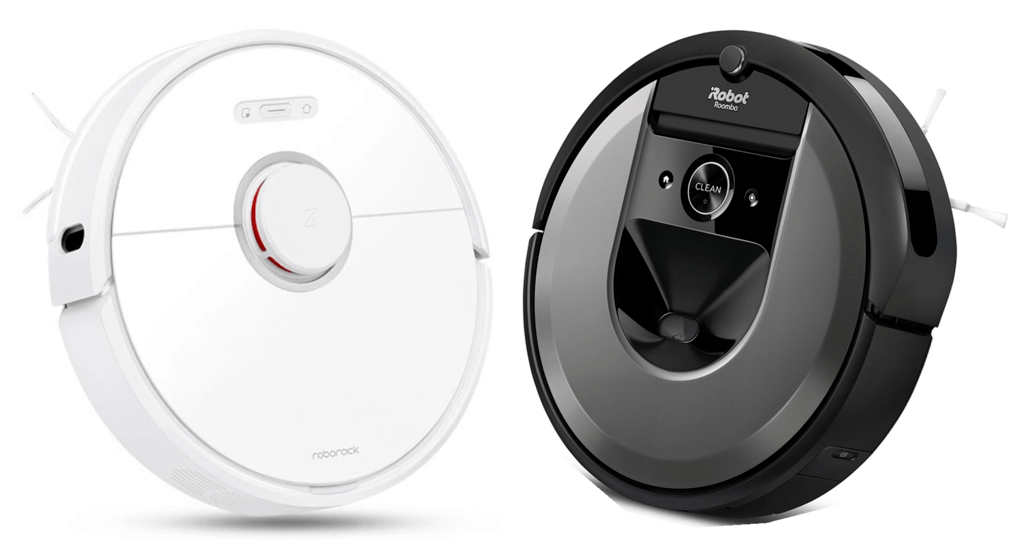Roborock continues to separate from the Xiaomi brand and push the robot cleaner market to new heights. In the meantime, the Roomba line continues to dominate with impressive technology and new configurations. The Roborock S6 attempts to capture a piece of the Roomba i7 market for itself.
If you are looking for your next robot vacuum, you have a lot of choices. This review will look at all the important details and compare the Roborock S6 vs. Roomba i7 to find out which one is the best option for you. While I pick the i7 as the better model, you may find that the S6 is a perfect fit for your home. Read on to find out why.
Contents
Differences between the Roborock S6 and Roomba i7
It is hard to find fault in most modern robot cleaners, and the Roborock S6 and Roomba i7 are no exception. Let’s take a look at where they differ from one another.
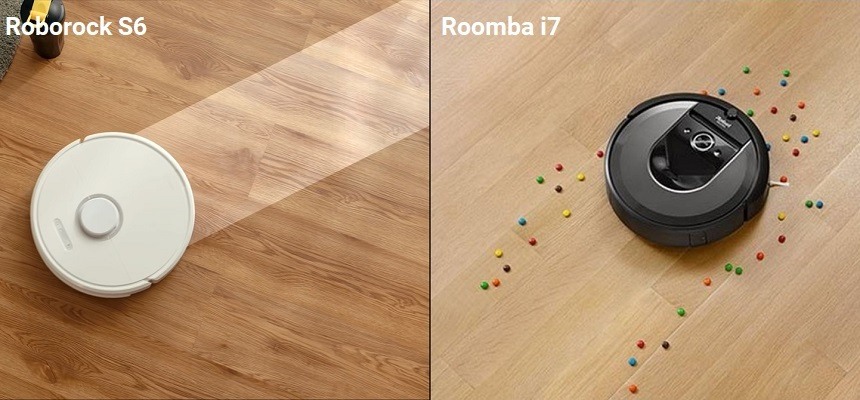
- The Roborock S6 has the ability to mop; the Roomba i7 doesn’t mop at all.
- The Roborock S6 doubles the runtime of the Roomba i7 with 250 minutes (Roomba runtime 120 minutes).
- Navigation and mapping. The Roomba i7 uses camera-based navigation and mapping while the Roborock S6 uses laser-guided LDS navigation.
- Imprint Technology. The i7 has Imprint Technology that allows communication between robots and enhanced mapping features. Roborock doesn’t have Imprint Technology.
- Select Room. Instead of Imprint Smart Mapping, the Roborock uses Select Room for scheduling and containment.
- Both robots have sensors, but the Roborock houses 14 of them while the Roomba only uses 8.
- Warranty period. You will get an extra year with the Roborock warranty than the 1-year warranty that comes with all Roomba models.
- The Roomba i7 can be upgraded to the i7+. There isn’t an upgrade option for the S6.
- Roomba uses the patented dual brushless extractors for debris collection. The Roborock model uses a brush roll.
Similarities between the Two Robots
Since both robots have similar duties around your home, they are bound to have commonalities between them. Let me show you the important similarities they share.
- Dimensions and weight. Both robots are similar in size and weight.
- Recharge and Resume. Each model will recharge its battery and resume cleaning after a charge.
- The i7 and S6 both use HEPA quality filters.
- Wireless and voice controls. You can use voice commands or the respective mobile app for each robot.
- Side brushes. Both machines utilize a single side brush for edges and corners.
- Digital containment. You can use the app to control where each robot cleans and when.
- Floor types. The Roborock S6 and Roomba i7 are both rated to clean all floor types.
Specifications Chart
Here we can see the two robots side by side and compare their features and options.
| Roomba i7 | Roborock S6 | |
| Dimensions | 13.34×13.34×3.63 inches | 13.7×13.8×3.8 inches |
| Weight | 7.44 pounds | 7.7 pounds |
| Battery | 3600mAh lithium-ion | 5200mAh lithium-ion |
| Runtime | Up to 120 minutes | Up to 250 minutes |
| Charge Time | 3 hours | 5 hours |
| Automatic Recharge | Yes | Yes |
| Automatic Resume | Yes | Yes |
| Filter | High-Efficiency | E-11 HEPA, washable |
| Motor Suction | About 2100pa | Up to 2000pa |
| Scheduling | Yes | Yes |
| Spot Cleaning | Yes | Yes |
| Real Time Location and Programming | Yes | Yes |
| Wireless Communications | Yes | Yes |
| Local Controls | Yes | Yes |
| Mobile App | Yes | Yes |
| Voice Commands | Yes | Yes |
| Navigation | iAdept 3.0 | Multi-Sensor Multi-Room |
| Mapping | Imprint Smart Technology | LDS |
| Collection Bin Capacity | 0.7L | 0.5L |
| Water Reservoir Capacity | N/A | 0.15L |
| Noise Level | 65dB | 50dB |
| Adjustable Water Level | N/A | Yes |
| Select Room Navigation | Yes | Yes |
| Select Room Scheduling | Yes | Yes |
| Multiple Maps Stored | Yes (10 maps) | Yes (3 maps) |
| Containment | Yes (app and physical) | Yes (app only) |
| Side Brush | 1 | 1 |
| Floor Types | All | All |
| Sensors | 8 | 14 |
| Dry Mop | N/A | No |
| Damp Mop | N/A | Yes |
| Wet Mop | N/A | Yes |
| Warranty | 1 year | 2 years |
| Price | Check on Amazon | Check on Amazon |
Comparing the Roborock S6 to the Roomba i7
Now we can get on with the good stuff. Let’s take a close look at the two robots and compare then side by side. By the end of this section, you should have a better understanding of how the two machines operate and which one is better suited for your needs.
Mopping is a One-Sided Venture
We might as well start the comparison off with a one-sided victory, right? The Roborock S6 can sweep, vacuum and mop. The Roomba robots don’t mop, so right away, Roborock gets a default win. Does it mop well, though?
The truth is that the Roborock line up would be a lot better off without the mopping feature. I tell you that so I can tell you this: the mop does work, and it works better than any previous model. If you are looking for a robot that can vacuum and mop, you have found one of the better ones.
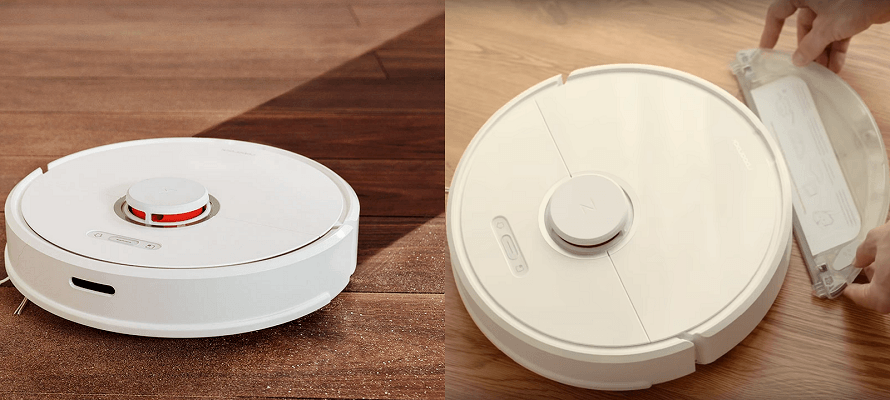
As you probably know, there is a true wet mop here. Unlike other models where you have to soak the pad or spray the floor, the Roborock S6 has a water tank that releases water on to the mopping pad, which is then dragged across the floor.
The Mop is More Advanced than the Roborock S5, Though
The one advancement over the S5 model is that the water flow can be adjusted. There is a toggle switch that allows you to choose between low flow and high flow. If you choose a low flow, the mopping pad gets wet, but it takes a while. The floor that gets cleaned before the pad is wet enough to make a difference, misses out.
If you have the toggle set to the high setting, the pad gets soaking wet, which then leaves streaks and tire tracks behind.
Roborock also recommends that you vacuum and sweep the floor before sending the robot out to mop. However, the recommendation is that you vacuum and sweep three times in a row and then mop on the 4th cycle. As you can tell, this is something most people aren’t willing to do, and even when the instructions are followed to the letter, you still end up with streaks, debris, and tire marks.
Bottom Line: The Roomba doesn’t mop, so the Roborock S6 wins this category. However, with the dismal performance of the mop, the Roomba might as well win.
Both Models Recharge and Resume
One feature that both models do share is the ability to recharge their batteries when they get low. The i7 and S6 both monitor their batteries, and when the charge level drops below about 15%, they return to their docking stations to top-up.
Once the batteries are recharged, if the cleaning cycle wasn’t completed, they will also return to the spot they left off and continue cleaning. Known as Recharge and Resume, this feature is only available on robot cleaners that have the ability to create and store maps. Both the Roomba i7 and Roborock S6 can create and store maps, which I will discuss in more detail further in the article.
The Roborock has a slight advantage here, though. When it stops a cleaning cycle to recharge the battery, it will stop the charging cycle when the battery reaches an 80% charge. It will then resume cleaning and return to charge the battery fully once the cleaning cycle is complete.
The Roomba will wait until the battery is completely charged before resuming. However, the i7 model will charge its battery to 100% about 45 minutes before the Roborock can charge the battery to 80%.
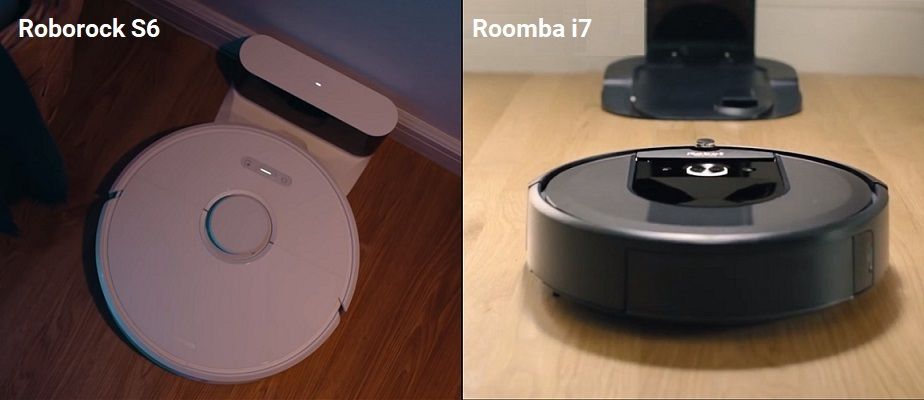
Bottom Line: The time it takes the Roborock to recharge its battery negates the “80% refill before resuming” feature, making this round a tie.
While both robots navigate your home and create maps of your floor plan, they go about it in different ways. Roomba uses iAdapt technology, which is a camera-based navigation system, and uses the new Imprint Technology to create and store maps.
On the other hand, Roborock uses laser-guided navigation (known as LDS) and mapping. The differences are purely in the manner the robots see and move around your home. Their abilities are basically identical.
Roomba’s system uses a low-resolution camera to take hundreds of pictures while the robot moves around the home. These images are then pieced together to create a 3-D model of your home’s layout. Using what iRobot calls Imprint Technology, the images and maps are rendered in the mobile app allowing you to see and interact with it. I will cover the mobile app and Imprint Technology a little bit later.
Roborock uses the laser to detect certain areas of your home. These areas include the walls, corners of the ceiling, large pieces of furniture, and certain landmark pieces like overhead lights, ceiling fans, etc.
The LDS then uses these points to create a 2-D map in the robot’s memory that is used for navigation and displayed in the mobile app (I’ll touch on this later on, too).
What you need to know is that it doesn’t matter if lasers or a camera does the map creation and navigation. In the end, the results are the same. You have a robot that knows where it is, where it has been, and where it needs to go next.
[easyazon_image align=”none” height=”500″ identifier=”B07RLRWWPJ” locale=”US” src=”https://smartrobotichome.com/wp-content/uploads/2020/01/51M1IlgQhL.jpg” tag=”srh-easyazon-20″ width=”500″]
[easyazon_image align=”none” height=”500″ identifier=”B07GNRGDKP” locale=”US” src=”https://smartrobotichome.com/wp-content/uploads/2020/01/51ZQnryLuPL.jpg” tag=”srh-easyazon-20″ width=”500″]
Bottom Line: Even with different methods of map creation and moving around your home, the robots are about equal in this regard. This round is a tie.
Wireless Communications and Control Options
The two robots use wireless communications to connect to your home network. Once connected, you can use a multitude of control options beyond the basic local controls. This is a good thing since the local controls on modern robots are minimal.
With wireless communications, you can utilize the respective robots’ mobile apps. The Roomba app is one of the most advanced and user-friendly robot vacuum apps on the market. Through the app, you can start, stop, pause, and resume cleaning cycles. You can also create and edit schedules, see status updates, robot locations, and reports on battery usage, areas cleaned, and much more.
The Roborock app is also quite intuitive once you get used to the clumsy interface. This isn’t the fault of Roborock. In fact, they are stepping out of previous app control through Xiaomi. In the past, Roborock, Xiaomi, and several other companies. Now that Roborock is basically building robots on their own, they have developed their own app.
The app still controls past robots, as does the Xiaomi app, but the Roborock S5 and S6 will only operate using the new Roborock app. With the app, much like the Roomba app, you can control the robot, see the maps it creates and make schedules. There are aspects of the app that have reports of crashing, glitches, and hangs. Some users report that the app needs to be restarted several times to connect. However, once connected, it works fine.
All of these issues are known and being addressed by Roborock. Constant updates fix known issues and conclude testing of other features.
Voice Controls Add to the Enjoyment, At Least for Roomba
Along with the mobile app, you can also use wireless communications to connect through Amazon Alexa and Google Assistant for voice controls. Roborock lacks in this area compared to iRobot, but at least they have something.
Roborock allows you to turn on or turn off the robot through Alexa. By turning it on, you also initiate a cleaning cycle. Likewise, when turning it off, the robot returns to the charging station. These are the only two controls you have at the moment.
The Roomba i7 has a lot more controls. In fact, you can start, stop and control the robot, tell it which room to clean (see the section below on Imprint Technology for more), create and edit schedules, and much more. You can find the full list of controls on the iRobot website.
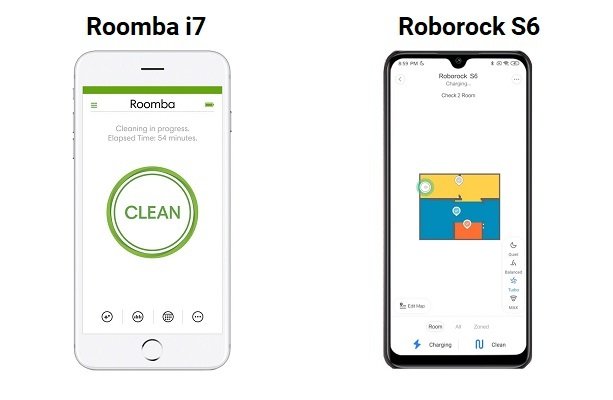
Bottom Line: With a better mobile app, the Roomba will win this round. The Mobile app is where you will use most of your control options, so having a better app is crucial. Having over two dozen voice controls doesn’t hurt either.
Filtration Costs Less with Roborock
I want to touch on the filters that these two machines use briefly. HEPA filtration is a big deal for some people. You can rest assured that both the i7 and S6 use HEPA quality filters. The Roomba vacuums use the term “high-efficiency” to refer to their filters that are HEPA rated.
HEPA ratings mean that a filter will capture particles known to cause allergies. These are things such as pet dander, mold and mildew spores, dust mites, and pollen. With a capacity to capture particles down to 3 microns, your floors will remain allergen-free (up to 99%) with either robot.
The Roborock S6 uses an E-11 HEPA filter. This filter is a thicker material and withstands several rinses. A washable filter will save you a bit of money in the long run, since you won’t have to replace them as often.
The main problem with washable filters, though, is that you have to wash them. Removal, large debris extraction, rinsing, and then waiting a minimum of 24 hours for them to dry. This can become tedious.
The E-11 filters found in the Roborock are reported to last for about 2 months before they need to be washed and can withstand up to four or five wash cycles before the filter material isn’t as effective and requires replacement.
Crunching the numbers, you will need to replace the filter at least once a year, sometimes twice a year. The Roomba i7 doesn’t have a washable filter. Instead, when the filter gets full, you will toss it out with your trash (recycling encouraged).
You should expect to burn through a couple of filters soon after your purchase. The initial runs will capture more debris than you think, and instead of a filter lasting 4 to 6 months, you will want to replace the first filter after the first 30 days.
In the end, you will go through just as many washable filters as disposable ones. You have to decide if you want to wash a filter or toss one.
Bottom Line: Both machines use highly effective HEPA filters. This round is a tie.
Imprint Technology or Select Room Features?
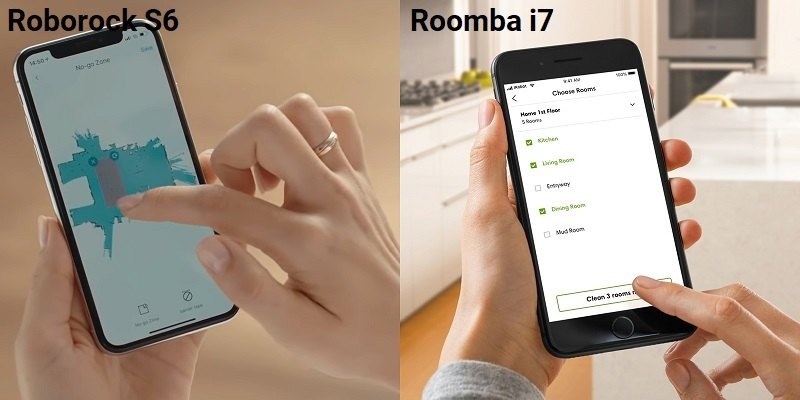
Both of the robots compared here today have a little extra feature that is worth discussing. For the Roomba i7, this is called Imprint Technology. The Roborock S6 doesn’t have a cute name for theirs, but I call it Select Room Technology.
Let’s start with Roborock. Through the mobile app, you will find extra control options. When you create your cleaning schedules, you will have the option to outline and label the rooms of your home found on the map. A thorough mapping run is required, which can take several runs through your home to complete. The Roborock can store three different floor plans.
Once the map is completed, you can then select a specific room to have cleaned. So, for instance, if you only want your living room vacuumed, you can tell the Roborock to only clean the living room.
It gets better, though. You can select multiple rooms and have them cleaned at different times. I call this the Select Time feature. So assume your household is on a schedule. Perhaps the kids go off to school at 7 am. Dad leaves for work at 9 am, and mom works from home. You can schedule the Roborock S6 to clean the kid’s bedrooms starting at 7 am. The master bedroom can be scheduled for cleaning at 10 am and the office during mom’s lunch break at 1 pm.
While this feature is nice to have, you will most likely want the entire house cleaned regularly. So this feature won’t replace your regular cleaning schedules, but it can be useful from time to time.
This feature also enables the only form of containment that Roborock offers. The s6 doesn’t have any form of physical containment, so you must rely on the mobile app. The feature is similar to Neato’s No-Go lines. You can mark areas on the mobile app’s map where you want the S6 to ignore. In theory, it works. In reality, it needs some tweaking.
The feature is now in its 3rd update and still has problems with the robot ignoring the commands. While this is being worked on, it can be troublesome if you want your living room vacuumed and it ends up in the kitchen instead.
Roomba’s Imprint Technology is Much More Advanced
With the i7, you have what is known as Imprint Technology. This is a two-part technology system. The first part, named Imprint Link, allows the i7 to communicate with the Braava M6 mopping robot.
The two robots can work in tandem off the same map. With Imprint Link, when the Roomba is finished cleaning a room, it will alert the Braava, who will then begin cleaning behind the vacuum. You can even set it up where the Roomba cleans only the carpeted areas while the M6 mops the hard flooring simultaneously.
The feature you want, though, is called Imprint Smart Mapping. The Roomba has the ability to store and recall ten different floor plans. Even if you move furniture around, the i7 will now which map to use based on the floor plan you put it in. Impressive at that is, there is much more.
Like the Roborock, you can also label and name your rooms on the map. What you cannot do (yet), is clean multiple rooms at different times. You can select specific rooms to clean, though, so you can limit the Roomba to only the living room, or include the bedrooms.
There is also a form of virtual containment. You can select entire rooms for the Roomba to avoid, specific areas of rooms to avoid, or create squares the robot is not allowed to enter. Unlike the Roborock, there are very few reported issues with Imprint Technology not working correctly. Most of those few instances have also been resolved as user error.
On top of all that, you also have the option to use your voice. With the Roomba i7, you can say things like “Alexa, have Roomba clean the living room.” What you cannot do with your voice is clean multiple rooms. At least not yet. iRobot has stated it is a feature they are working on.
You can use physical containment as well. The Roomba i7 is compatible with the dual-mode virtual wall barriers. You can use as many barriers as you like (a separate purchase), and the robot will obey the barriers as well as the digital containment, so your options are limitless.
Bottom Line: Roborock has a few quirks to work out, but they are on the right track. For now, though, Roomba i7 gets the win for a fully functional feature set.
Frequently Asked Questions
There are certain questions that pop up from time to time. I will attempt to answer those questions here. If you have other questions, feel free to ask in the comment section below the article.
Q. What is the Roborock S6 warranty? How do I make a claim?
A. The Roborock S6 comes with a 24-month warranty. This is maintained and supported through Amazon. Eventually, you will be able to register your purchase through the Roborock website. As of this writing, the page has existed since June 27th, 2019, but is not active yet. For warranty claims, you must go through Amazon.
Q. How do I contact iRobot customer service?
A. You can contact iRobot through various methods. There is a general phone number for technical support and inquiries, 1-800-727-9077. You can also email tech, sales, and pre-sales or initiate a live chat. These latter options can be found on the iRobot customer service page.
Q. What is the warranty on the Roomba i7? How do I make a claim?
A. The Roomba i7 comes with a 12-month warranty, and you can initiate a claim through Amazon (if purchased there) or through iRobot’s site. You will need to provide proof of purchase, all the details, and cover shipping. Further warranty details are on the iRobot warranty page.
Q. Is the Roborock quieter than the Roomba?
A. The Roborock does produce less noise on average than the Roomba model. Roborock’s S6 has an average decibel rating of 50dB, which is fairly quiet, to be honest. The Roomba i7 varies between about 56 and 65dB, depending on mode and cleaning surface.
Q. What is the Roomba i7 upgrade? Is it worth it?
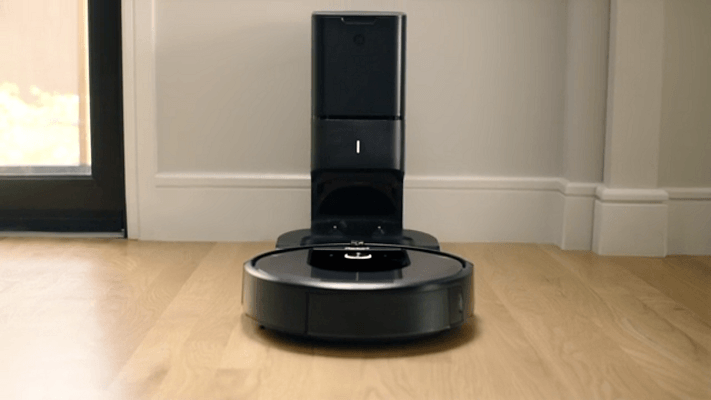
A. The Roomba i7 can be upgraded to the i7+. The only difference between the two is the ability for the Plus model to empty its own collection bin. You can purchase the i7+ directly or upgrade the i7 by purchasing the upgrade kit, which comes with the Clean Base charging station, two dust bags, and the Clean Base collection bin for the robot. The cost for the upgrade kit is more expensive than buying the i7+ outright, but in general, the upgrade isn’t worth it. Stick with the i7 base model.
What I Like About the Roomba i7
- Imprint Technology is the best in the business.
- Ideal and efficient runtime for moderate and large-sized homes.
- Can be upgraded later to the Roomba i7+.
What I Like About the Roborock S6
- HEPA filter is washable.
- Mopping feature makes the S6 a true all-in-one robot.
- Huge battery offers a massive 250 minute runtime.
Conclusion
The robot vacuum market is saturated. When you are looking for your next robot, you have plenty to choose from. If you find yourself looking at the Roborock S6 to save money versus the known capabilities and reliability of the Roomba i7, it can be a daunting choice.
The Roborock S6 can mop, has smart home integration, and a mobile app that has a few problems but is otherwise impressive. While Roborock hasn’t quite nailed the robot vacuum market just yet, the S6 is an impressive model in its own right.
Compared to the Roomba i7, though, the S6 doesn’t stand a chance. The Roomba cleans better, works harder, and is more efficient. If you want to save money, the Roborock is a decent enough robot. If you are looking for quality and durability, though, the Roomba i7 is your best bet.
